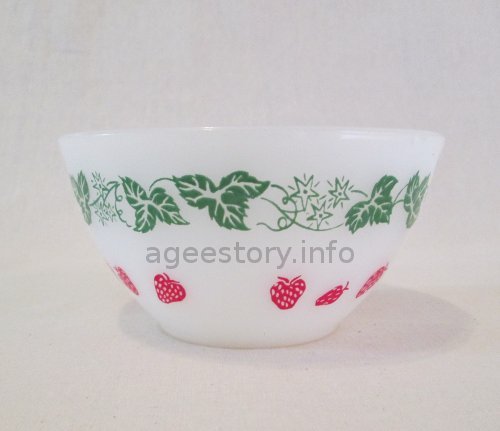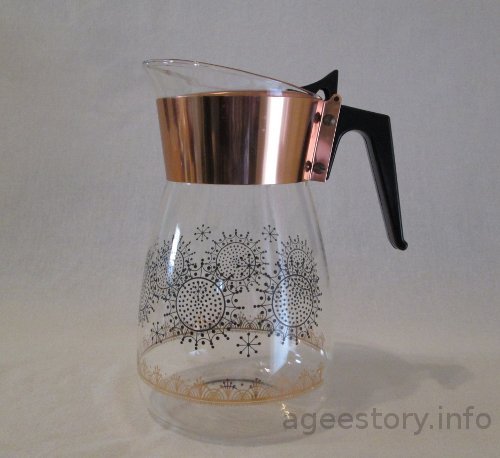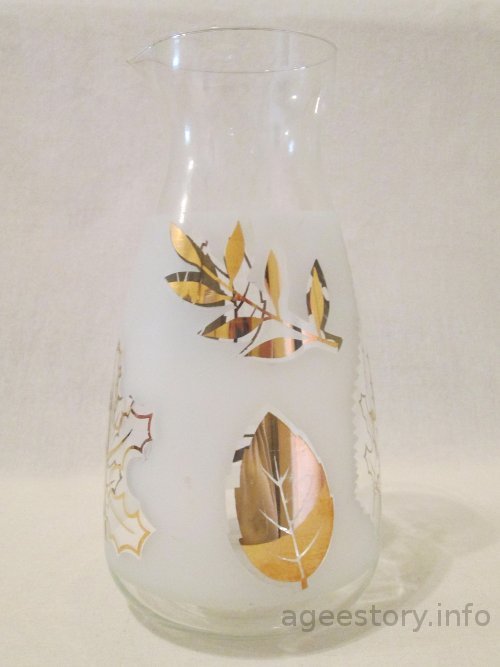

If your piece has other markings, use the guide for marked items instead.
 Almost all pieces of pressed Australian pyrex were clearly marked.
The main exceptions are the round nesting mixing bowls made in the
1960s and 1970s, which were
made in four sizes: 5¼", 6¼", 7¼" and 8¼".
Most have blank bases.
Almost all pieces of pressed Australian pyrex were clearly marked.
The main exceptions are the round nesting mixing bowls made in the
1960s and 1970s, which were
made in four sizes: 5¼", 6¼", 7¼" and 8¼".
Most have blank bases.
There is little doubt that the decorated opal bowls are made of pyrex glass. There are surviving ads for some of them, and many have matching casserole dishes and other pieces. Nevertheless, as with all unmarked glassware, secondhand owners need to make their own decision whether or not to treat an unmarked item as heat-proof or microwave-safe. The author of this website is not responsible for deciding whether your unmarked bowl is made of pyrex glass or not.
Advertisements and mint-condition items have confirmed that Crown used
packaging and stickers to identify unmarked mixing bowls as pyrex glass
when they were originally sold.
 Coffee jugs and percolators are also unmarked.
These are hand blown and have noticeably thinner walls than pressed
pyrex items.
Coffee jugs and percolators are also unmarked.
These are hand blown and have noticeably thinner walls than pressed
pyrex items.
The shape shown on the left was advertised in the 1960s and 1970s, and could be bought with a candle-warmer stand, as seen in this 1963 ad for Crown gifts. The percolator version has a glass knob on the lid.
Handle and lid shape are the keys to distinguishing Crown's coffee jugs
from other brands.
Some earlier models can be seen in these ads:
Pyrex glass
cannot be heated directly on the stovetop.
This is why Crown Pyrex's percolator instruction leaflet
showed the vessel protected by a wire gauze mat.
As stoves and cooktops vary, you should ask the
manufacturer of your appliance for the correct method to use today.
 Pyrex juice jugs are hand blown as well.
Notice
the delicate triangular pouring lip at top left.
The jug shown here has lost its plastic stopper, which fitted into
the neck of the jug to keep the juice fresh.
Pyrex juice jugs are hand blown as well.
Notice
the delicate triangular pouring lip at top left.
The jug shown here has lost its plastic stopper, which fitted into
the neck of the jug to keep the juice fresh.
Juice jugs were available from the mid 1960s and were often sold in a set with matching tumblers, which would be made of ordinary glass. The decoration shown at the left, Golden Frost, was available on a wide range of Crown products.
It is unclear whether all juice jugs were made of pyrex glass.
Some Crown juice sets can be seen in these ads:
As they are unmarked,
it is wise to treat all juice jugs as though
they are made of ordinary glass, not pyrex.
Copyright notice:
All content of this website is copyright to the
respective copyright owner(s).
No part of this website may be reproduced without the express
consent of the relevant copyright owner(s).
All rights reserved.
 Back to Navigation Page
Back to Navigation Page
Disclaimer:
In Australia, the name PYREX
is currently registered as a trademark owned
by Corning Incorporated, USA.
This website has no association with Corning Incorporated, Crown Commercial,
or any manufacturer of heatproof glassware.